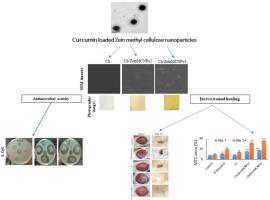Reinforcing chitosan film with a natural nanofiller “Zein-methyl cellulose loaded curcumin” for improving its physicochemical properties and wound healing activity
IF 6.2
Q1 CHEMISTRY, APPLIED
Carbohydrate Polymer Technologies and Applications
Pub Date : 2024-11-02
DOI:10.1016/j.carpta.2024.100593
引用次数: 0
Abstract
Selecting the appropriate biomaterials for fabricating a wound dressing is an essential issue for accelerating the process of wound healing. The biopolymer “chitosan” attracted attention owing to its non-toxicity, biocompatibility, and biodegradability. However, chitosan showed poor mechanical, antioxidant and antibacterial properties. These limitations can be encountered by its conjugation with a nanofiller reinforcing and improving the film properties. The proposed nanofiller, derived from zein-methylcellulose loaded curcumin (ZeinMCNPs) was incorporated with different concentrations into a chitosan matrix (Ch) forming Ch/ZeinMCNPs1–3 films. Ch/ZeinMCNPs3 film showed a significant improvement in tensile strength, elongation at break% and Young's modulus over Ch film. Notably, the antibacterial and antioxidant activities of the Ch/ZeinMCNP1–3 films signified enhancement over chitosan. In wound rat model, wound healing contraction reached 96 % and 98 % for Ch/ZeinMCNPs2,3 opposite to 79 % for Ch film. In Ch/ZeinMCNPs2,3 treated wounds, H&E tissues sections revealed a reduction in inflammation, an enhancement in re-epithelization and neovascularization. Furthermore, Ch/ZeinMCNPs2,3 films boosted more collagen deposition as shown in MTC sections. Ch/ZeinMCNPs2,3 significantly increased SOD level (at day 7 and14) with a decrease in MDA level. Overall, the present study declares Ch/ZeinMCNPs nanocomposite film as a multifunctional wound dressing category covering the necessitates required for accelerating wound healing process safely.

用天然纳米填料 "添加姜黄素的玉米素-甲基纤维素 "增强壳聚糖薄膜,以改善其理化特性和伤口愈合活性
选择合适的生物材料制作伤口敷料是加速伤口愈合过程的关键问题。生物聚合物 "壳聚糖 "因其无毒性、生物相容性和生物可降解性而备受关注。然而,壳聚糖的机械、抗氧化和抗菌性能较差。通过将壳聚糖与纳米填料共轭,可以增强和改善薄膜的性能,从而克服这些局限性。拟议中的纳米填料来自负载姜黄素的玉米素-甲基纤维素(ZeinMCNPs),以不同的浓度加入壳聚糖基质(Ch)中,形成 Ch/ZeinMCNPs1-3 薄膜。与 Ch 薄膜相比,Ch/ZeinMCNPs3 薄膜的拉伸强度、断裂伸长率和杨氏模量都有显著提高。值得注意的是,Ch/ZeinMCNPs1-3 薄膜的抗菌和抗氧化活性明显高于壳聚糖。在大鼠伤口模型中,Ch/ZeinMCNPs2,3 的伤口愈合收缩率分别达到 96% 和 98%,而 Ch 膜仅为 79%。在 Ch/ZeinMCNPs2,3 处理过的伤口中,H&E 组织切片显示炎症减轻,再上皮和新生血管增加。此外,如 MTC 切片所示,Ch/ZeinMCNPs2,3 薄膜促进了更多胶原蛋白的沉积。Ch/ZeinMCNPs2,3 能显著提高 SOD 水平(第 7 天和第 14 天),同时降低 MDA 水平。总之,本研究表明 Ch/ZeinMCNPs 纳米复合膜是一种多功能伤口敷料,可安全地加速伤口愈合过程。
本文章由计算机程序翻译,如有差异,请以英文原文为准。
求助全文
约1分钟内获得全文
求助全文

 求助内容:
求助内容: 应助结果提醒方式:
应助结果提醒方式:


